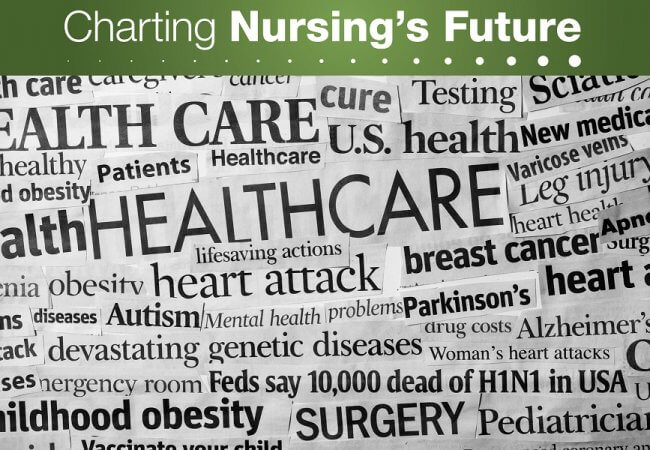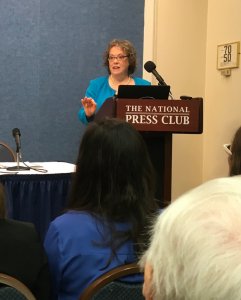
May 08, 2018
Nurses Remain Largely Invisible in the Media

A 1998 study of nurses’ voices in the media found that nurses were “largely invisible” in leading print publications. Twenty years later, little has changed.
That’s the sobering conclusion of The Woodhull Study Revisited: Nurses’ Representation in Health News Media, released today by the Center for Health Policy and Media Engagement at the George Washington University School of Nursing.
“In 1997, nurses appeared as sources in 4 percent of daily newspaper articles and in 1 percent of articles in weekly and industry publications. In 2017 nurses were quoted in 2 percent of newspaper articles and in 1 percent of articles in weekly and industry publications,” said a study author, Laura Nixon, MPH, senior media researcher at Berkeley Media Studies Group, who spoke during a press conference announcing the release of the report’s findings.
The authors also found that nurses were rarely identified in photographs and noted that their voices are “conspicuously absent” in discussions of health policy, the business of health care, and research. Even articles about the nursing profession use nurses as sources only 44 percent of the time.
Why are nurses’ voices absent from news stories that would benefit from their expertise?
The researchers offer several explanations.
- Ninety percent of nurses are women, who are statistically half as likely as men to be quoted in the media.
- When reporters call communications staff at health care organizations and universities, typically the default practice is to forward the request to a physician.
- Publication style guidelines often mandate that physicians be identified through the honorific “Dr.” while discouraging the use of credentials such as RN for other professionals. As a result, some nurses may be hidden in plain sight, with only their administrative, research, or policymaking role visible to readers.
Through 10 interviews with health journalists, the researchers also discovered that nurses may need to educate journalists about their profession before seeing significant progress in how nurses are represented in the media. The interviews revealed that journalists are generally perplexed by the various credentials that follow nurses’ names. Reporters also lack a clear understanding of the range of nurses’ roles and the significance of various educational backgrounds. And counterintuitive as it may seem, the media has trouble finding nurses to interview despite their large numbers.
“Nurses aren’t strategic in engaging journalists,” said Barbara Glickstein, MPH, MS, RN, director of communications and media projects for the George Washington School of Nursing Center for Health Policy and Media Engagement. “Neither are nursing journals,” she added, “although reporters regularly hear from medical journals.”
To get a handle on how nurses communicate with the wider world, the study authors reviewed the use of social-media hashtags (keywords that allow users to access comments on particular topics) at 47 leading nursing schools. The researchers found that, by and large, nursing schools use “inward-facing” hashtags to communicate with other nurses rather than as a tool to reach out and grab the attention of the media and others.
Nursing schools house a wealth of clinical and policy expertise among their faculty that could enrich coverage of a wide range of issues, but that message is not reaching journalists. Currently just over 1 percent of schools’ social media followers are members of the media.
The Woodhull Study Revisited focused solely on current publications that were already in print in 1997 in order to make an apples-to-apples comparison, but the media landscape has undergone seismic shifts in the last 20 years. The researchers agreed that a follow-up study of how nurses are used as sources by online publications and broadcast media would give a fuller picture.

Diana Mason, PhD, RN, FAAN, lead author
Will nurses’ media visibility increase in the next 20 years? That’s unclear, but as the study’s lead author Diana J. Mason, PhD, RN, FAAN, pointed out, the answer matters as much for the consumers of the news as it does for nurses. “Diversity of sources is key to good journalism,” she told those gathered at the press event. The Senior Policy Service Professor for George Washington School of Nursing Center for Health Policy and Media Engagement urged the journalists present to look to nurses as sources and urged nurses and their institutions to do more to engage the media.
Nurses: How to Make Yourselves Visible
- Use social media.
- Write op-eds and letters to the editor.
- If a reporter contacts you, call back—immediately, if you can.
(Reporters are often on deadline and may use the first sources they reach.)
- Keep a list of colleagues the media can talk to if you are unavailable.
- Reach out and share your stories with reporters or the media department where you work.
- Seek media training.
To learn more, check out these helpful resources.
- RN = Real News: Media Relations & You
An online independent study module aimed at helping prepare RNs to use media to communicate and advance their nursing organization’s objectives.
- Media Tools for NPs
This website features “how-to” advice on writing a press release, preparing for an interview, and more. (Available to American Association of Nurse Practitioners [AANP] members only.)
- The OpEd Project
An organization offering programs, resources, and online suggestions to help improve written and spoken media communication skills.
- Nurse Messenger Media Training
Customized workshops in strategic messaging for your workplace or association.
